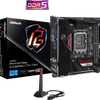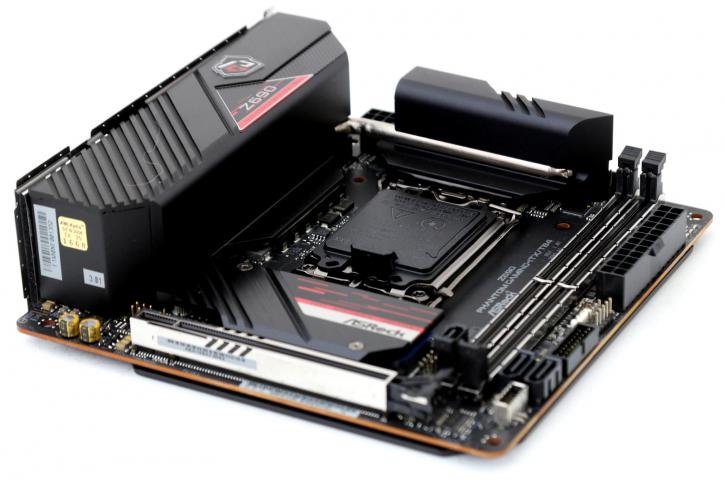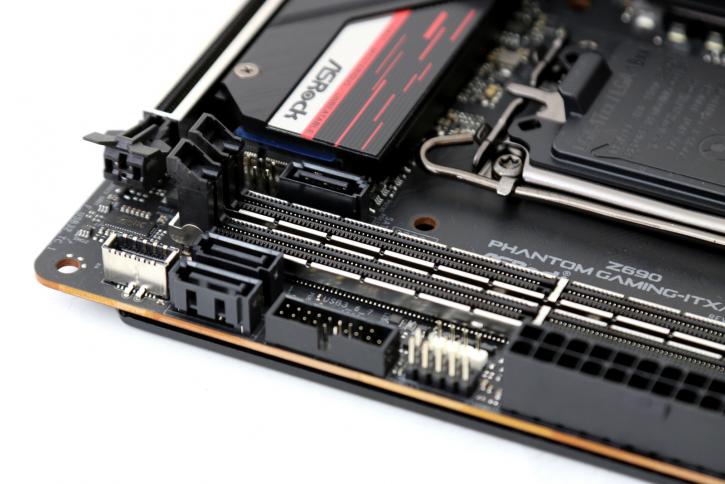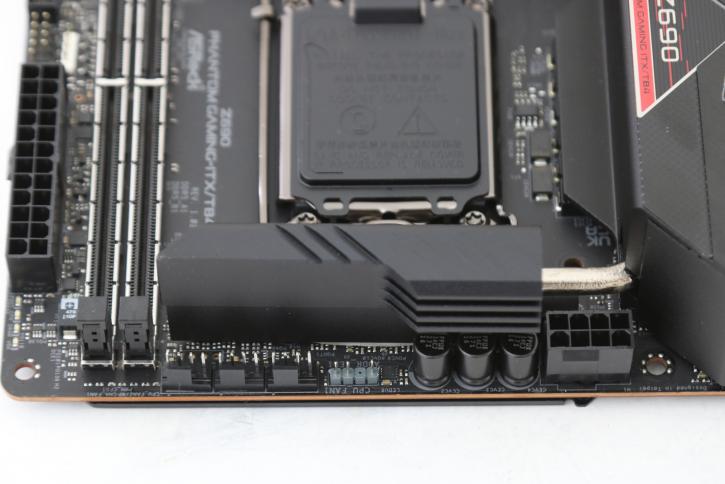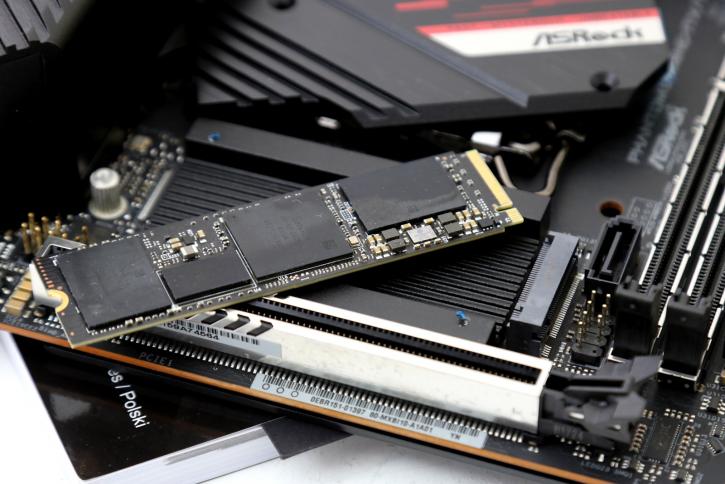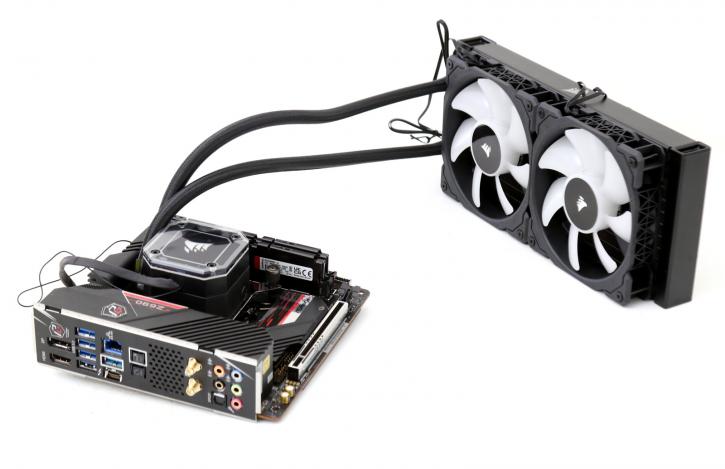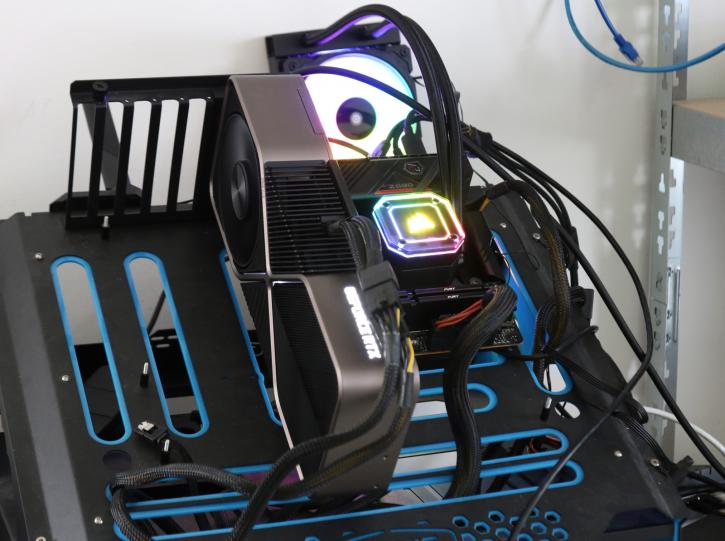Product Showcase
Product Showcase
A considerable number of internal storage ports and headers are located on this side of the board. Here, you'll find three SATA III ports, an internal USB 3.2 Gen2 Type-C header, and a USB 3.2 Gen1 header. The PCIe socket is strengthened with metal and reinforced buckles inlaid with metal brackets, which increases the socket's supporting force and decreases the likelihood of it being torn apart. Additionally, to support PCIe 5.0 transfer speeds of up to 128GB/s, PCIE1 replaced the standard DIP PCIe slot with SMT surface mount technology, which provides more reliable signal transmission and reduces the likelihood of signal attenuation.
To your lower left, you can see yellow capacitors that's the audio circuitry. The motherboard features a Realtek ALC1220 Audio Codec audio chip that supports up to 8-channel theater-grade surround sound, audio formats up to 32-bit / 192KHz, DSD playback, and a 120dB audio Noise Ratio (SNR) for post-sound output quality. Additionally, it utilizes Nippon Chemi-Con audio capacitors and the Ti NE5532 ear amplifier chip, which allows for automatic detection and optimization of headphone impedance settings, as well as up to 600 output gain adjustment to meet the requirements of various headphone specifications, delivering the ultimate in transparency and purity. Audio, which provides professional players with realistic sound effects.
The new Z690 chipset motherboard is compatible with the new LGA 1700 CPU interface. The look is markedly different than that of the previous LGA 115X and 1200. Not only does it transform from a square to a rectangle, but it also measures 37.5mm x 45.0mm. Although this generation's processor interface is designated as LGA 1700, the actual number of LGA pins is 1800, with 100 pins yet to be defined and allocated for future CPUs as additional power or I/O pins. In terms of memory, the ASROCK Z690 Phantom Gaming-ITX/TB4 motherboard features the Z690 DDR5 version, which includes two sets of DDR5 DIMM expansion slots, Dual Channel support, and a 1 DIMM Per Channel configuration. Each DIMM expansion slot supports a maximum capacity of 32GB, while the maximum system memory capacity thus is 64GB.
The grooves have been relocated to two locations on the top and bottom, rather than one on each side. The most significant modification is that the socket loading plate's opening is now similar to that of LGA 1366, and the socket rod is positioned opposite the loading plate. ASROCK Z690 Phantom Gaming-ITX/TB4 features two M.2 SSD interface configurations, one on the front and one on the rear of the motherboard, each supporting up to PCIe 4.0 x4 and PCIe 4.0 x4 respectively.
The M2 1 slot on the front is tied towards CPU LANES, while the M2 2 slot on the back is provided by the Z690 chipset, they support RAID 0, RAID 1, and RAID5. For heat dissipation of high-speed M.2 SSD devices, the front M2 slot is fitted with metal heat sinks. These heat sinks help prevent overheating and slowing down, (throttling) ensuring that high-speed M.2 SSDs can consistently deliver the best-read and write speeds. Regrettably, the M2 2 slot on the back lacks an inferior metal heat sink. The interfaces on the board are densely packed, and there are just a few of them to examine. Perhaps the location of the CMOS battery, as well as the lack of physical connectors for power users, are the things that are lacking here in this design.
The board is fitted with Killer AX1675i Wi-Fi 6E gaming wireless network module, which actually is based on the Intel AX211 wireless network module. It offers a low-latency gaming connection experience; supports IEEE 802.11ax dual-band 2x2 160MHz Wi-Fi technology; and down-supports IEEE 802.11 a/b/g/n/ac wireless network protocol; the highest frequency band has been upgraded from 5GHz to 6GHz; and the highest wireless network protocol has been downgraded from IEEE 802.11 a/b/g/n/ac. The connection speed could reach 3Gbps, resulting in faster transmission and lower latency over short distances. Simultaneously, it features Bluetooth 5.2, which enables connectivity with next-generation smartphones, wearable devices, and smart home items.
Yeah at 17x17cm you need to look carefully, to the left of that RTX 3090 ;)
